The pendulum swing between libertarianism and puritanism recurs throughout history. During my lifetime I have seen the swinging sixties, the laid-back seventies and the indulgent eighties give way to a period of relative severity with regard to the ethics of environmental responsibility and social justice, along with a move towards restraint in eating and drinking, and the stigmatization of smoking.
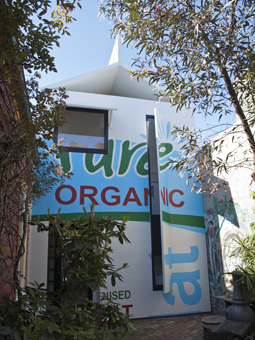
In sexuality the emphasis is now on responsibility rather than excess, and woe betide the adult who casts an interested eye towards someone wearing a school uniform. In art, this caution has extended to controversy over the photographic work of Bill Henson.
Architecture in particular is subject to a severe rationale. Footprints, carbon and building plan alike, should be small for the sake of the planet. Eco-puritanism is now a style of design, involving rectilinear plans, constrained spaces, recycled timber and ‘natural’ colours chosen to harmonise with new-growth green. While I agree wholeheartedly with improving the sustainability of architecture, I think it is important to stop short of creating a style for ‘green’ architecture because it closes off analysis and new solutions.
One way to avoid a repetitious approach is to search for a fictive departure point. Rather than embarking on yet another piece of documentary architecture dealing with the topic of sustainability, a fictional narrative grants a critical perspective. In the case of this project the site presented the opportunity for me to deal with a long-term preoccupation with shaping buildings in the form of used food packages. The new energy that brought this proposal to life at this time was a link with art history.

The tradition of still-life painting embraces the notion that art should reflect the actual surroundings and normal artifacts found in everyday life. For the Dutch painters of the sixteenth century this meant cutlery, fruit, vegetables, fabric and dead birds. For Andy Warhol it meant the cans of Campbell’s Soup that provided easy-to-prepare ‘nutritious’ food, readily available from a supermarket nearby.
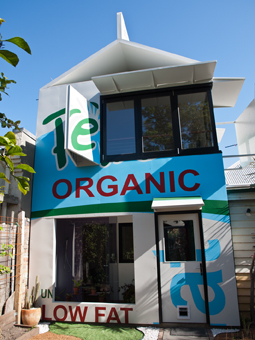
Shifting forward fifty years, to another continent, the staple product that stands out on our suburban kitchen table is Pure Unhomogenised Organic Low-Fat milk. Furthermore, the notion of ‘still life found object’ is applied to architecture in this case rather than to art practice, in a move where the architect and viewer adopt the premise, widely expected in painting, that the narrative within the work is fictional.
The Milk Carton can be described as fiction architecture because visitors take part in the pretence that they are entering a giant Tetra-Pak. This allows them an overview of the wider philosophical landscape within which our current set of assumptions about architecture lies.
The spaces are small and mainly white, enlightened with milk drop-shaped light fittings. The stair is hardly wide enough to allow access. Light abounds and the footprint is small.
The graphics on the carton refer to ‘good’ qualities such as ‘pure’, ‘organic’, ‘low-fat’ and ‘unhomogenised’.

Milk is the primary source of nourishment for the newborn and hence has connotations of goodness, naturalness and nutrition. The theme of ‘milk’ also allows us to contemplate whiteness, and therefore consistency and untaintedness, and other associations that this colour has. Whiteness implies its opposite, blackness, which of course has its own set of connotations. The two together allow the possibility of oppositional thinking and, when taken to an extreme, puritanism.
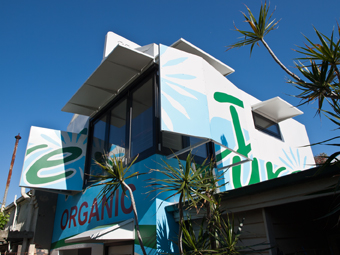
When puritanical attitudes are challenged, history shows that fanaticism may arise, particularly when fuelled by a desire for the acquisition of property, money or political advancement. It is well-known that witches were drowned or burned, but it is not often mentioned that their estates – in many cases of considerable value – were also confiscated.
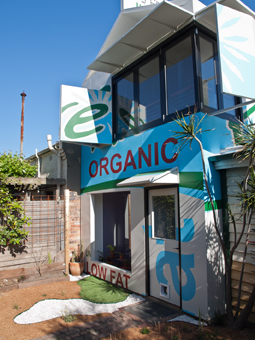
The word ‘unhomogenised’ is replete with nuances. The implications of the phrase go beyond the dairy farm to our culture in general. We used to believe in assimilation of migrants and the elimination of aboriginality, moving in the direction of homogeneity. This is now considered a very bad attitude, and so the word ‘unhomogenised’ engenders a generalized feeling of well-being, as well as the more specific attribute of reducing the degree to which fats in the milk contribute to fatty tissue in the body.
This brings us to the phrase ‘low fat’. Perhaps the most disturbing prejudice of our food-obsessed culture is the notion that fat is bad, and therefore fat people are bad. Fat people are immoral! They have clogged arteries and heart disease. The thinner you are, the fitter you are, and the fitter you are, the better you are. Thin people are morally pure.
‘Pure’ is the name of the product itself. Rather than calling it ‘milk’, which is associated with its high-floating cousin ‘cream’, and therefore early death and extreme obesity, the product has assumed a more abstract quality. You can’t argue with ‘pure’. It is free of pollutants such as pesticides. In terms of morality, it is free from sin. In farming terms, it is ‘organic’. Out of manure emerges pure white ambrosia.
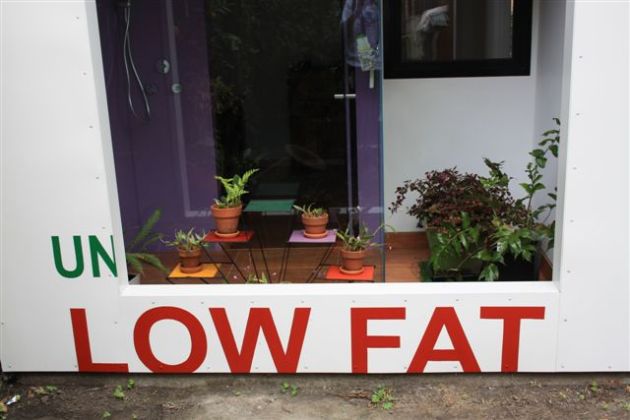
These thoughts are just a sample of the themes that may be contemplated by a person who takes part in the pretence that they are dealing with a gargantuan beverage container.
I hope that enjoyment will flow abundantly.
Footnote: In the accompanying photographs the large upper floor windows face the northern winter sun and the rear yard. The vertical screens are to protect the privacy of the neighbouring back yards. The extension is to the east side of the house and the south façade, shown in the first photograph, faces the street.
Credits: The Milk Carton house extension would not have been possible without the owners Jen Carmichael and Neil Davis, Craig Jones the builder, all the subbies and the sign writing team. Special credit to Neil for his meticulous work modifying and adapting the graphic design. Spilt milk landscaping designed and executed by Jen and Neil. Photos by Neil. Thanks also to Clara Friedhoff, my trusty assistant.
There is a YouTube video of the extension combined with commentary from 3RRR community radio ‘The Architects’ program at http://www.youtube.com/watch?v=RNWAEJ70Jao






